How is Softball Different Than Baseball: A Comparison
Exploring how is softball different than baseball leads us into an intriguing examination of two sports that seem alike. Though both celebrate teamwork, strategy, and the joy of hitting and running, they part ways in surprising details. The differences affect everything from player approach to game tactics. Why do these variations exist, and how do they define each sport’s unique essence? Read on to discover the distinct elements that set softball and baseball apart, offering unique experiences to players and fans alike.
Understanding Both Games: Baseball and Softball
Before we get into the details, let’s talk about what makes baseball and softball special. In both games, teams try to score runs by hitting a ball and running around the bases. They require hand-eye coordination, athleticism, strategy, and teamwork. Men traditionally play baseball at the professional level, while women and youth players increasingly enjoy softball.
Take a Deeper Look at the Origins of Both Softball and Baseball
To grasp the distinctions between softball and baseball, it’s crucial to look into their historical backgrounds and how they’ve evolved. Baseball predates softball by over a century, with its rules codified in 1845 by Alexander Joy Cartwright. In contrast, people believe softball began as an indoor variation of the game, with its first known game played in Chicago in 1887. Over time, both sports have evolved and gained their unique identities.
See Also: How to Make a Baseball
Softball Origins
Softball’s origins can be traced back to a Thanksgiving Day event in Chicago in 1887. It began as an indoor game, initially called “indoor baseball” or “kitten ball.” As the game gained popularity, it underwent several transformations, including the adoption of standardized rules in 1934 by the Joint Rules Committee on Softball. Since then, softball has become a widely played outdoor sport, known for its fast-paced action and inclusivity.
Baseball Origins
Baseball, known as America’s favorite sport, has a long history that goes way back. It started from older games played with sticks and balls and became popular in the 18th century. In 1845, the New York Knickerbocker Baseball Club established standardized rules, leading to the first official baseball game a year later. Major League Baseball, consisting of the National League and the American League, has become a professional sport enjoyed by millions worldwide.
Softballs vs Baseballs: A Comparison
One of the most noticeable differences between both games is in the equipment, especially the balls. Softballs and baseballs have distinct characteristics that affect gameplay and player experience.
Circumference of Softballs vs Baseballs
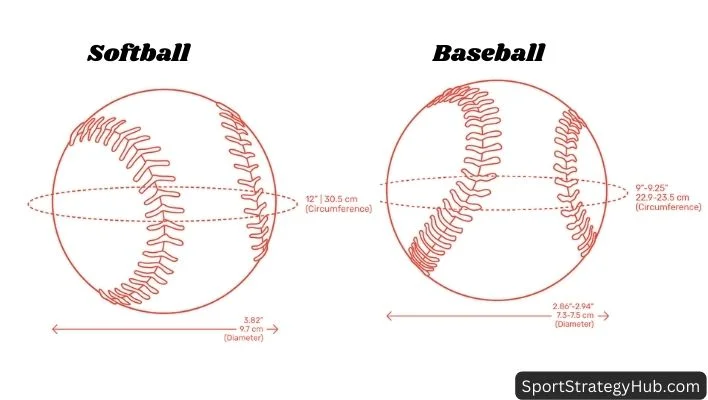
Softballs have a larger circumference compared to baseballs. Softballs are usually about 12 inches in circumference, whereas baseballs measure approximately 9 to 9.25 inches around. The size difference impacts the way the balls are thrown, caught, and hit, contributing to the unique dynamics of each sport.
Weight of Softballs vs Baseballs
Another difference between softballs and baseballs is their weight. Softballs are generally heavier than baseballs, ranging from 6 1/4 to 7 ounces. Baseballs, on the other hand, weigh between 5 to 5 1/4 ounces. This difference in weight impacts how fast and in what direction the ball moves when it’s pitched, caught, or hit.
Color of Softballs vs Baseballs
Softballs and baseballs also differ in terms of color. Softballs are typically yellow, while baseballs have a white cover.
This distinction helps players distinguish between the two types of balls during gameplay.
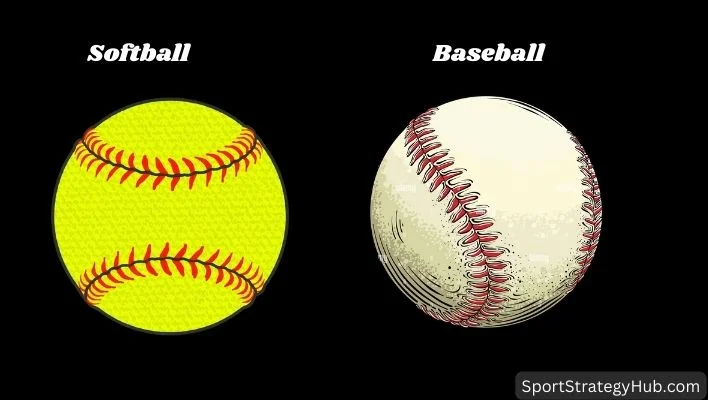
Batting Equipment
When it comes to batting, both sports require players to use specialized equipment, including bats. While there are similarities in terms of shape and purpose, there are also notable differences in bat design and regulations.
Bat Designs for Baseball vs Softball
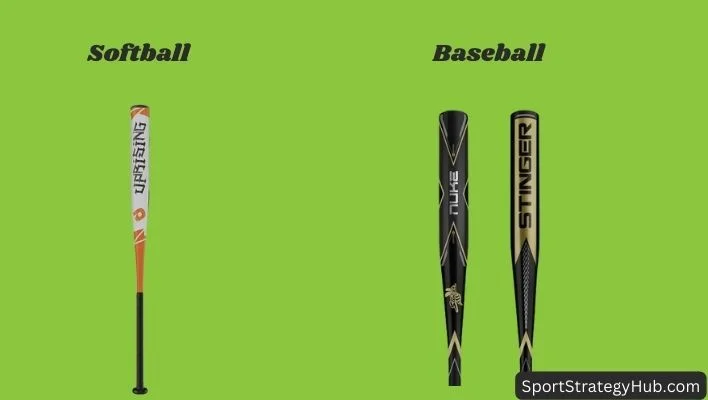
Bats used in baseball and softball may appear similar at first glance, but there are subtle differences. Baseball bats are usually longer, thicker, and heavier than softball bats. In professional baseball, players can only use wooden bats, but in softball and amateur baseball, they can use bats made of wood, metal, or different materials.
Length and Weight Sizes for Softball vs Baseball Bats
The length and weight of bats also differ between both games. Softball bats are usually shorter, with a maximum length of 34 inches, while baseball bats can measure up to 42 inches. The weight of the bats is also influenced by the requirements of each sport, with baseball bats generally being heavier than softball bats.
Fielding Equipment
Both softball and baseball require fielders to wear specific gear to protect themselves and enhance their performance. From gloves to protective equipment, here’s a closer look at the equipment used by fielders in both sports.
Fielding Gloves for Softball vs Baseball
Gloves for fielding are essential equipment for both game players. While the basic function of the gloves remains the same – to catch and secure the ball – there are differences in design and size. Softball gloves are usually bigger, with deeper pockets, to fit the larger softball. Baseball gloves vary in size based on the player’s position, with infielders using smaller gloves for faster transfers and outfielders choosing larger gloves for catching fly balls.
Softball vs Baseball Glove Sizes by Position
In both softball and baseball, players in different positions need gloves of different sizes to perform their best. In softball, the catcher’s mitt is the largest to accommodate the size of the softball and provide additional padding for catching fast pitches. In baseball, infielders use smaller gloves for faster transfers and throws, while outfielders use larger gloves to catch fly balls securely.
Protective Fielding Gear
Fielders in both sports may also wear additional protective gear to minimize the risk of injury. This can involve things like face masks, chest protectors, shin guards, and helmets. The exact gear used might differ based on the level of play and what players prefer.
Pitching Styles
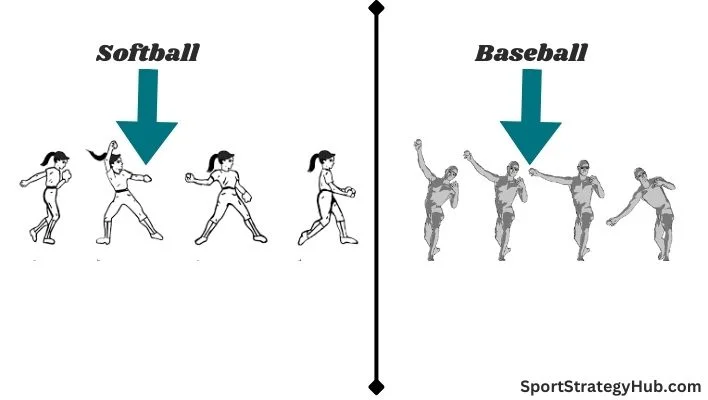
One of the most apparent distinctions between softball and baseball is in the way pitching is done. The way the ball is thrown by the pitcher significantly impacts the dynamics and strategies employed by both teams.
Why Do Softball Pitchers Throw Underhand?
In softball, pitchers throw the ball underhand from a specific pitching circle. This underhand pitching style allows for greater control and accuracy. In softball, the distance between the pitcher and the batter is shorter, with the ball traveling around 43 feet. Softball pitchers can achieve impressive speeds, with the fastest recorded pitch reaching 77 mph.
Pitching in Baseball
Unlike softball, baseball pitchers throw the ball overhand or sidearm from a raised mound positioned 60 feet and 6 inches away from home plate. The overhand pitching style in baseball enables pitchers to generate more power and speed, resulting in faster pitches. The fastest recorded pitch in baseball reached a staggering 105.1 mph.
Field Dimensions
Another major difference between softball and baseball is in the size and layout of the playing fields. The dimensions of the field affect the gameplay and strategies employed by teams in both sports.
Professional Baseball Field Dimensions
Professional baseball fields adhere to specific dimensions. The outfield fence is usually about 400 feet away from home plate at its farthest point. The distance between bases is 90 feet, providing players with more space to cover and making base running a crucial aspect of the game.
Professional Softball Field Dimensions
In professional softball, the field dimensions are smaller compared to baseball. The outfield fence is usually closer, typically measuring no more than 250 yards. The distance between bases in softball is 60 feet, creating a tighter playing area that requires quick reflexes and strategic decision-making.
Length of Game
The duration of games differs between both games. The number of innings and game length can impact the pace, strategy, and overall experience for players and spectators.
Games are 9 Innings in Baseball versus 7 Innings in Softball
In baseball, games usually have nine innings. But if the score is tied after nine innings, they can play more innings until one team wins. In softball, games are usually seven innings long. If the score is tied after seven innings, they can also play extra innings to decide the winner, just like in baseball.
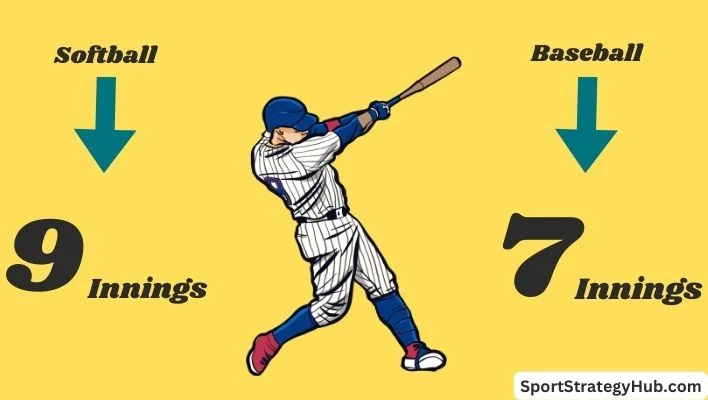
Frequently Asked Questions
The main difference lies in the pitching style, field dimensions, ball size, and game duration. In softball, pitchers throw underhand from a flat pitching circle, whereas in baseball, pitchers throw overhand from an elevated mound. Softball fields are smaller, and games are typically seven innings, whereas baseball fields are larger, and games consist of nine innings.
The answer varies based on personal views and choices. While both sports require skill, coordination, and strategy, softball may be perceived as more accessible due to its underhand pitching style and smaller field dimensions. However, each sport poses its unique challenges and offers its own rewards.
Historically, softball has provided more opportunities for female athletes, with dedicated leagues and organized competitions. While some girls and women do play baseball, they may choose softball due to its established infrastructure, cultural acceptance, and the availability of resources tailored to female players.
In general, baseball pitchers tend to throw faster than softball pitchers. The longer pitching distance in baseball, combined with the overhand throwing motion, allows for higher velocities. However, this does not diminish the skill and speed of elite softball pitchers, who can still reach impressive speeds in their underhand throws.
While both sports share similarities in terms of gameplay and objectives, there are specific rule variations between softball and baseball. These variations include pitching techniques, field dimensions, game duration, and other nuances that cater to the unique characteristics of each sport.
Conclusion
In conclusion, softball and baseball may share some fundamental aspects, but they also have distinct differences that shape the gameplay, equipment, and strategies used in each sport. From the pitching style to the field dimensions and equipment, these differences contribute to the unique identities and appeal of both games. Whether you’re a fan or a player, understanding these differences can make you appreciate and enjoy both sports even more. So, grab a bat or glove and experience the thrill of softball and baseball for yourself!
